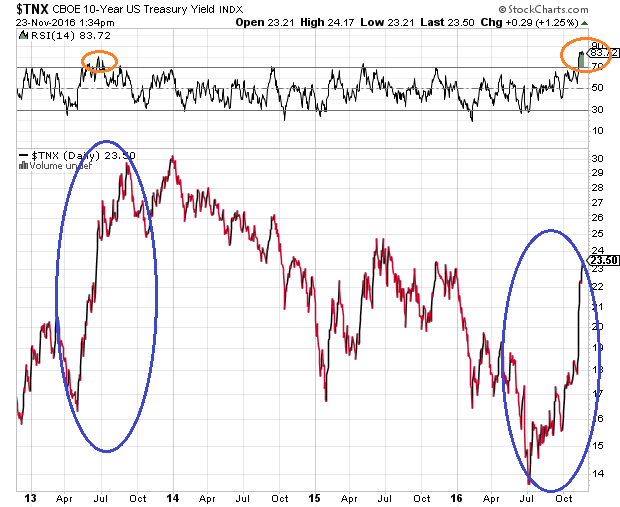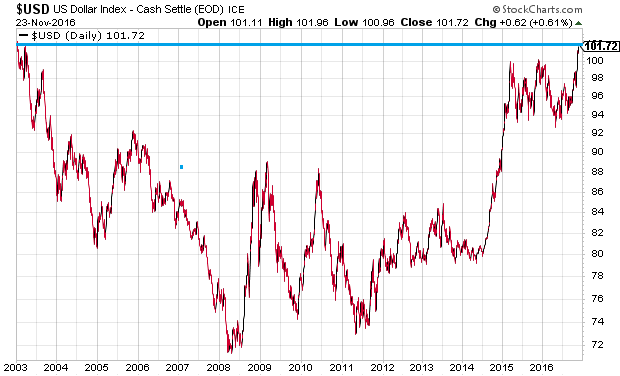For several years, ultra-low interest rates “justified” paying higher stock prices for anemic earnings growth. The 10-year Treasury yield traded in a tight range between 2.0%-2.5%. Borrowing costs remained stable or continued to fall. Indeed, the notion that rates would remain extremely low for a very long time encouraged many to pony up for a price-to-earnings (P/E) multiple of 19.
Throughout the first ten months of 2016, though, a sub-2% 10-year Treasury prompted investors to pay even higher equity valuations. Contracting profits? Not important. Diminishing revenue? Not relevant. For many folks, S&P 500 stocks were still “attractive” because its 2% dividend surpassed 1.5%-1.75% for the intermediate-term treasury benchmark.
In July and August, then, with the trailing P/E at 25, there were few dissenters. Low rates trumped everything from “Brexit” fears to deteriorating credit fundamentals to year-over-year declines in fixed asset expenditures.

The recent election of Donald Trump, however, has changed the nature of the argument. Specifically, the President-elect coupled with a Republican-led administration in Congress may bring back superior economic growth. Great labor force participation. Less onerous regulation. A 21st century industrial revolution. And through it all, business success that did not rely too heavily on ever-decreasing borrowing costs.
Is it possible? Perhaps. Are businesses, consumers and the U.S. government really going to move away from credit dependency? I doubt it.
For one thing, market participants are currently speculating that inflation-creating trade restrictions, ongoing annual deficits and the probability of substantial increases in the national debt warrant higher interest rates. The 10-year Treasury yield literally pole vaulted from the 1.75% level up to 2.35%. In actuality, it has moved 100 basis points from the record summertime lows. (Say goodbye to those mortgage “refis.”)

Secondly, people are underestimating the impact of tighter financial circumstances. Mortgage demand? Housing prices? Both are not likely to tolerate much more of a shock to the system. Higher wages may be coming down the path, but the effect would not be felt until 2018 or later.
Third, there’s little point in denying that the 13-year high for the greenback is a significant headwind for corporate profits. The greater the Federal Reserve agrees with the market on inflation prospects – the more the Fed touts the attainment of full employment – the higher the U.S. dollar may go. That’ll crimp exports. That’ll damage revenue earned in foreign currencies. It could even cause a credit crisis for emerging market borrowers of dollar-denominated debt.

As it stands, then, investors are back to paying 25x the earnings per S&P 500 shares. The difference? The multiple at 25.3 has a 2.35% 10-year Treasury yield rather than a 1.35% 10-year Treasury yield. What’s more, market participants paid 19x S&P 500 earnings with 2.0%-2.5% yields between mid-2013 and year-end 2015.
So why exactly is there a great deal of serenity about the lofty valuations today? The hope that Trump can get it done? I’m not persuaded that the current valuations make sense, regardless of who sits in the Oval Office.
Assume for a moment that the new administration does what Wall Street is hoping for. It removes barriers on small business by doing away with tedious regulations. It invests federal tax revenue into infrastructure projects. It renegotiates trade agreements. It replaces the ill-conceived Affordable Care Act (ACA). It even manages to lower corporate tax payments as well as streamlines the overall tax code.
Each and every legislative action would require time to take effect. Meanwhile, tighter financial conditions – higher borrowing costs, elevated dollar – create problems in the present. Worse yet, there is no certainty that the benefits of the legislative actions will work swimmingly. Isn’t it possible that barriers to trade will cause import prices to soar, forcing the Fed to become more aggressive in hiking rates to fight inflation? Isn’t it conceivable that government infrastructure spending will turn out to be wasteful, adding more to precarious debt levels and making it more difficult to borrow-n-spend in the future?
Perhaps others do not see the risks with the Dow above 19000 and the S&P above 2200. What do I see? I see the interest rate “justification” falling by the wayside at the same time that valuations are hitting bull market extremes.
Disclosure: Gary Gordon, MS, CFP is the president of Pacific Park Financial, Inc., a Registered Investment Adviser with the SEC. Gary Gordon, Pacific Park Financial, Inc, and/or its clients June hold positions in the ETFs, mutual funds, and/or any investment asset mentioned above. The commentary does not constitute individualized investment advice. The opinions offered herein are not personalized recommendations to buy, sell or hold securities. At times, issuers of exchange-traded products compensate Pacific Park Financial, Inc. or its subsidiaries for advertising at the ETF Expert web site. ETF Expert content is created independently of any advertising relationships.
